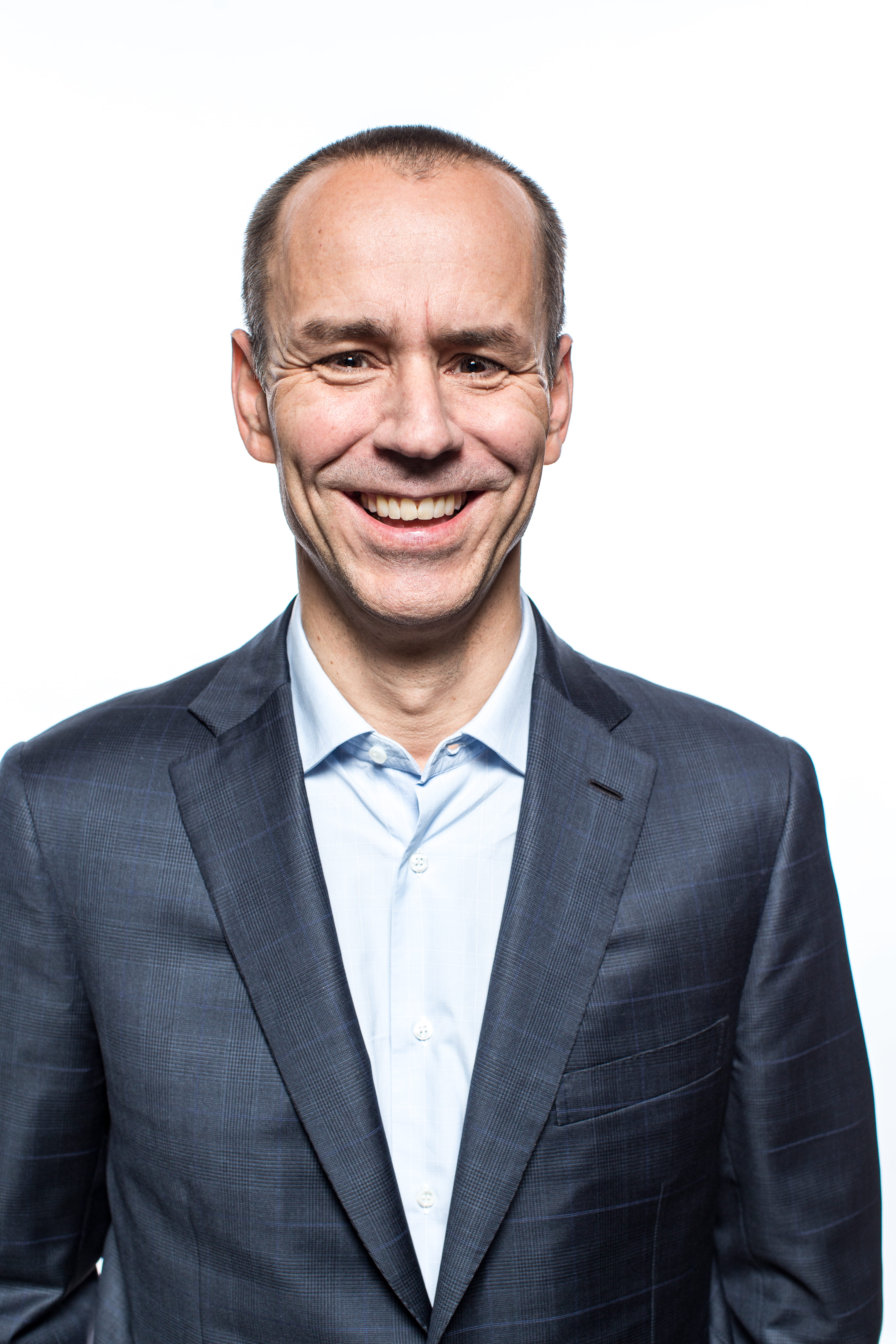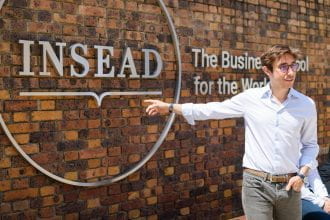By treating setbacks and mistakes as opportunities for innovation, Cimpress founder and CEO Robert Keane transformed a fledgling start-up into a $2 billion company

Ilian Mihov, Dean of INSEAD, Robert Keane MBA’94D and Sadia Khan MBA’95D, President of the IAA
Robert Keane MBA’94D spent his time at INSEAD with a business problem—and the determination to solve it. Out of a job due to a restructuring at the company where he worked at before coming to INSEAD and determined to start his own company, Robert spent his time in Fontainebleau building a business plan. He recognised that small businesses were underserved when it came to affordable, high-quality marketing materials and he had seen U.S. companies start to fill that market need. Restless to bring the concept to Europe, he began jogging with his two dogs through the beautiful countryside surrounding the Fontainebleau campus to help focus his thoughts.
“Some of my favourite memories from that time are running with them through the fields,” he remembers. “I was obsessed with the details of starting up this business and constantly exploring different ideas while I ran. It gave me this great clarity.”
The combination of rolling French landscapes and stimulating conversations with professors and classmates about his business helped him fine-tune his idea.
“By the time the spring and summer came, I was testing and hanging different pieces of the business off this frame I was building,” he says.
That business idea eventually crystallised into a direct marketing catalogue of desktop publishing software and stationery named Bonne Impression. Four years later, Robert would transform the company into Vistaprint, now a billion-dollar e-commerce company that helps millions of small businesses around the world market themselves via a range of affordable printing products and design tools. Vistaprint in turn became the launch pad for Cimpress, the corporate entity that now oversees Vistaprint and a portfolio of almost 20 other customer-focused mass customisation brands across the globe. Today, Robert continues to lead as Cimpress’ founder, president and CEO.
It’s a remarkable entrepreneurial success story and one that hasn’t gone unnoticed by INSEAD alumni. Earlier this year, the INSEAD Alumni Association selected Robert as the first recipient of its most prestigious award for entrepreneurs: The INSEAD Alumni Global Entrepreneurship Award.
Striking out
Going from a struggling start-up to more than $2 billion in annual revenues wasn’t an overnight success story. In fact, Robert’s business nearly ended soon after it started.
Almost a decade after graduating with an economics degree from Harvard College, Robert’s vision to revolutionise the short-run printing market grew from his experience developing a kiosk-based graphic design and printing system. That project failed, but the experience convinced Robert that there was a big opportunity.
While at INSEAD, he researched an American start-up that had been very successful with serving a similar market need, but who did so via a direct mail catalogue for desktop-based design and printing. After graduation, Robert started the company Bonne Impression to bring the concept to Europe. He then developed a relationship with Microsoft, thanks in large part to an introduction from classmate Liz Dunn MBA’94D, who worked at the software giant. Robert simultaneously worked as an external consultant to Microsoft’s European headquarters in Paris, researching the small business desktop publishing software market for the Microsoft Publisher product team.
Microsoft France eventually agreed to include the Bonne Impression catalogue, which offered small business stationery for the desktop printing of leaflets, stationery, business cards and newsletters, in each box of Microsoft Publisher and to let Robert mail his catalogue to Microsoft small business customers. In November 1995, while running Bonne Impression out of his Paris apartment, Robert put the very first edition of the direct mail catalogues in the post.
Just a day or two later, a strike was called to protest the government’s plan to reform work regulations. It became the longest general strike in French history, lasting more than two months. The post office ended up burning all third-class postage direct mailings because of the backlog.
“They only refunded us our postage,” Robert says. “No revenue came in and we were immediately on the verge of bankruptcy.”
The money he’d borrowed, raised and personally invested to fund the business was burnt, along with those catalogues. Robert stayed up at night trying to figure out what to do next. He turned once more to his INSEAD connections and family for answers.
“There was a professor, several classmates, and friends and family (including the woman he would later marry, Heather Keane) who had already invested before the strike,” he shares. “I said, ‘Would you mind investing some more? Because all the money is gone, but this is a really good idea.’”
With the help of this network, Robert was able to start again. “You have to have a little bit of blind optimism because if you actually look at the odds of any start-up actually succeeding, they are all typically very low. But support from others is even more crucial,” he says.
The company started growing, “often tripping yet always getting back up,” says Robert. He went back to INSEAD to recruit the third employee of the company, Patrick Mataix MBA’96J. Together they raised even more funding from angel investors and a French VC firm and, in late 1997, purchased the failing UK division of the same American firm that had originally inspired the Bonne Impression idea. They expanded from France into the United Kingdom and Germany.

Robert Keane MBA’94D
Holding on to the rocket
As the internet rose to prominence, Bonne Impression’s investors began to ask Robert what he planned to do online. Equally important, the growth of Bonne Impression was slowing and investors had lost interest in businesses that weren’t dot-coms. By the end of 1998, Robert was convinced the future lay in e-commerce.
“Once we focused on the Internet, we saw so much opportunity. We started saying, ‘What if we built a desktop publishing programme that ran a browser? What if we stop buying and reselling Microsoft Publisher and instead give our own browser-based design software away for free?’” The winning formula for this new project, which Robert named Vistaprint, was to combine that frontend browser software with patented backend software that slashed the cost of short-run printing.
The company raised more venture capital funding, and Robert recruited classmate Alex Schowtka MBA’95J to get the technology off the ground as Vistaprint’s chief operating officer. The company launched Vistaprint in June 1999 in France and the UK and expanded to the United States in early 2000. To build volume, Vistaprint then launched a bold marketing offer: free business cards, with customers only paying the cost of postage and handling.
And then came the dot-com crash. Funding dried up. To keep Vistaprint afloat, Robert sold the Bonne Impression catalogue business, reduced staff by 70%, and turned to his brother and father’s packaging printing business for support.
The drastic measures worked. The brand went viral, and Vistaprint’s revenues skyrocketed—growing from $0 in 1999 to $3 million in 2001, $35 million by 2003, and $800 million annually by 2010. Along the way, the company went public on the U.S. NASDAQ exchange.
“The Vistaprint business model just clicked in,” Robert says. “We call that the phase of ‘holding on to the rocket.’ It was incredibly exhilarating.”
But, once again, Robert recognised the need to reinvent the company. Growth was slowing and the Vistaprint brand was increasingly held back by its reputation for deep-discount but not-great-quality products. In mid-2012, Robert told his shareholders about a multi-year plan to reposition Vistaprint for higher quality and more transparent pricing and to invest in new growth businesses. That growth trajectory continued in the years that followed, and in 2014, Vistaprint’s parent company was renamed Cimpress. Today, it’s the world leader in mass customisation.
Business as a force for good
Beyond his incredible success as an entrepreneur, Robert is known for something else: serving as a socially conscious leader who uses business as a force for good.
For example, he has implemented policies to ensure that the working conditions for Cimpress’ 10,000 team members—who are based all around the world—are exceptionally high, regardless of location. That’s not only in terms of the office and factory conditions but in terms of how people are treated.
“We have a commitment to the quality of respect; our policies and hotlines against harassment in Mumbai, Tunis or Manila are the same as in Amsterdam or Boston,” he explains. “Whether it be confronting discrimination and sexism, or improving safety, we take responsibility.”
Robert has also worked with the Forest Sustainability Council to ensure that Cimpress uses sustainably forested paper products. In addition, Cimpress is voluntarily investing to reduce its carbon emissions in accordance with UN objectives for keeping global warming at 2 degrees Celsius or below.
“I think it’s very important to have businesses that are a force for good,” Robert says. “Besides being the right thing to do, it helps you get the best employees. You attract and retain much better people if they know they’re working for a company that has a social conscience.”
A career worth celebrating
This spring, the INSEAD Alumni Association recognised Robert’s accomplishments by naming him the first recipient of the INSEAD Alumni Global Entrepreneurship Award, which acknowledges alumni founders or co-founders of a company recognised for its global impact in terms of economic performance, reach, innovation and diversity. The award was presented in June 2017 at the INSEAD Alumni Forum Europe in Paris.
The award recognises Robert’s tremendous success as a global entrepreneur and the positive impact his work and Cimpress have on society. Cimpress was chosen due to its global reach, dedication to business practices that promote a sustainable future, inclusive and diverse work environment, and commitment to conducting business with the highest standards. The award fosters the culture of entrepreneurship in the global INSEAD alumni community.
Lessons learned
Last year, Cimpress’ brands served nearly 17 million customers, took more than 30 million orders and produced 46 million uniquely designed items. As the company moves forward in its mission to offer customisable, affordable products in small quantities, Robert notes that it will continue to focus on innovating in an ever-changing marketplace, learning from mistakes made along the way.
“When you’re on the cutting edge, things don’t always work,” Robert says. “We’re creating a culture where people realise that trying new things that don’t work out is actually a good thing, as long as you fail fast and move quickly to find something that works. That environment is really important to allow for innovation.”
Editor’s note: In the 2017-2018 academic year, the INSEAD Alumni Association and INSEAD will introduce two new additional awards, namely the INSEAD Alumni Force for Good Award and the INSEAD Alumni Volunteer Leader Award, to recognise extraordinary achievements and to provide inspiration and leadership to the community. In the 2018-2019 academic year, there are plans to add an Alumni Achievement Award.


